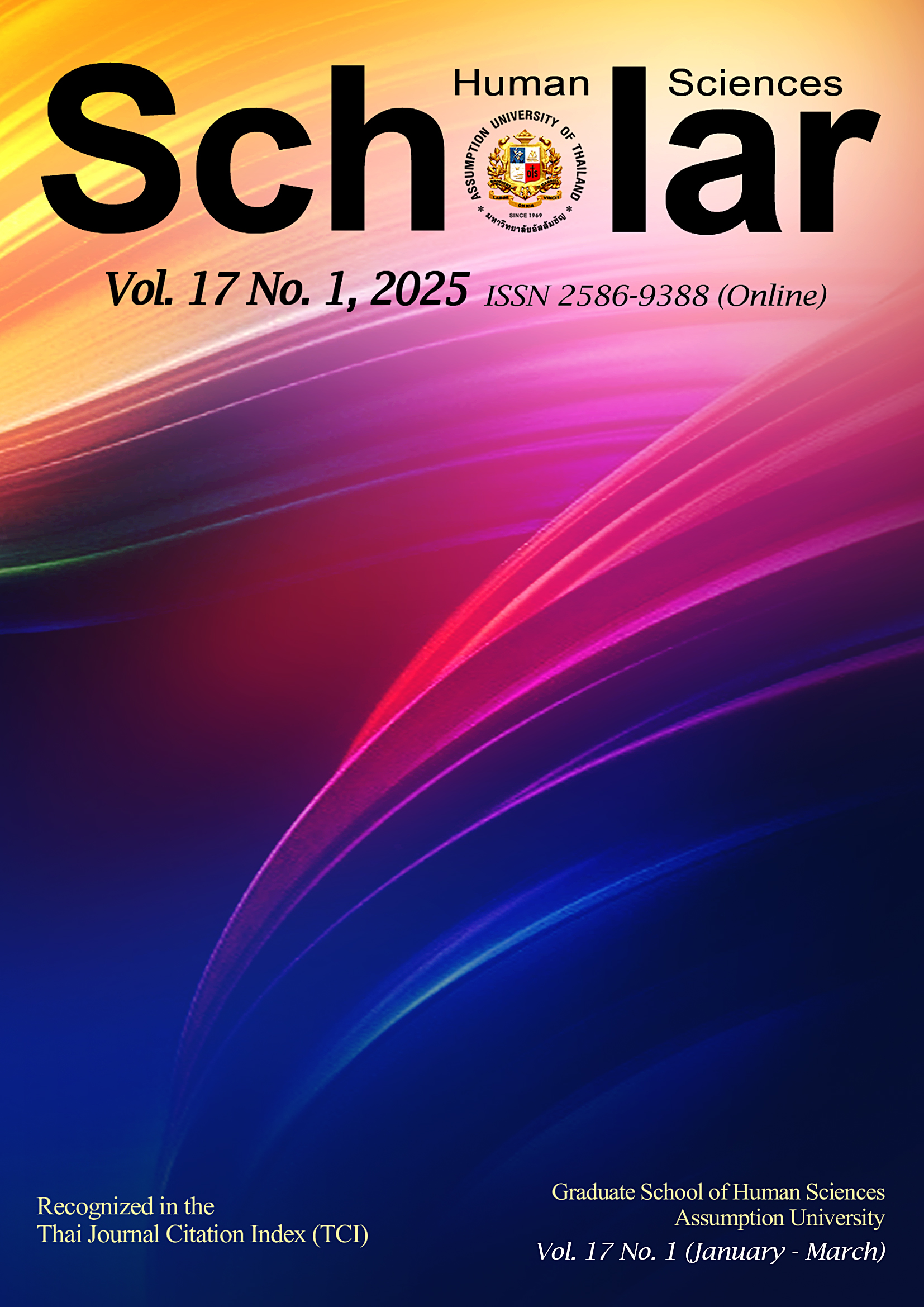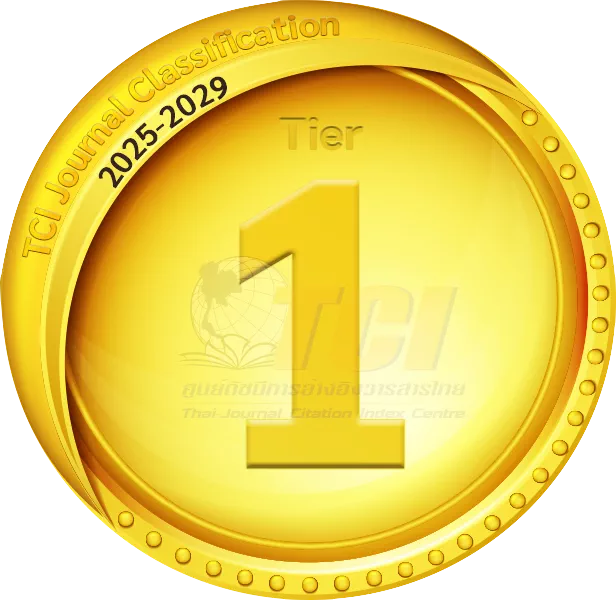The Influencing Factors of Superstar Learning System Satisfaction of Students Majoring in Environmental Design: A Case Study of Normal Universities in Sichuan Province
DOI:
https://doi.org/10.14456/shserj.2025.21Keywords:
Information Quality, System Quality, Perceived Ease of Use, Perceived Usefulness, Perceived EnjoymentAbstract
Purpose: This study aimed to explore the satisfaction and attitude of environmental design students in Sichuan Normal universities when using the superstar learning system in a blended learning environment. The conceptual framework contains information quality, system quality, perceived usefulness, perceived ease of use, perceived enjoyment, attitude and satisfaction. Research design, data, and methodology: The researchers conducted a detailed survey of the student population, using questionnaires to collect data. The subjects of this survey are mainly undergraduates majoring in environmental design from three universities in Sichuan, namely Leshan Normal University, China West Normal University, and Mian Yang Teachers’ College. The collected data was analyzed by rigorous confirmatory factor analysis and structural equation modeling to verify the fit of the study model and determine the causal relationship between the variables. Results: Information quality and system quality significantly impact perceived usefulness. Perceived ease of use significantly impacts attitude and satisfaction. Perceived usefulness has a significant impact on attitude, and satisfaction. In addition, perceived enjoyment has a significant impact on satisfaction. Conclusions: This study provides valuable guidance for improving undergraduate educational practice and, at the same time, helps to develop policies and strategies to promote the effective integration of education, technology, and management.
References
Ajzen, I. (2012). Attitudes and persuasion. In K. Deaux & M. Snyder (Eds.), The Oxford handbook of personality and social psychology (pp. 367-393). Oxford University Press.
https://doi.org/10.1093/oxfordhb/9780195398991.013.0015
Al-Busaidi, K. A., & Alshihi, H. (2012). Key factors to instructors’ satisfaction of learning management systems in blended learning. Journal of Computing in Higher Education, 24(1), 18-39. https://doi.org/10.1007/s12528-011-9051-x
Al-Debei, M. M., Akroush, M. N., & Ashouri, M. I. (2015). Consumer attitudes towards online shopping: The effects of trust, perceived benefits, and perceived web quality. Internet Research, 25(5), 707-733. https://doi.org/10.1108/intr-05-2014-0146
Al-Mamary, Y. H., & Shamsuddin, A. (2015). Testing of the Technology Acceptance Model in Context of Yemen. Mediterranean Journal of Social Sciences, 6(4), 268-273.
https://doi.org/10.5901/mjss.2015.v6n4s1p268
Armitage, C. J., & Conner, M. (2001). Efficacy of the theory of planned behavior: A meta‐analytic review. British journal of social psychology, 40(4), 471-499.
https://doi.org/10.1348/014466601164939
Awang, Z. (2012). Structural equation modeling using AMOS graphic (1st ed.). Penerbit Universiti Teknologi MARA.
Bandura, A. (1986). Social Foundations of Thought and Action: A Social Cognitive Theory (1st ed.). Prentice Hall.
Bentler, P. M. (1990). Comparative fit indexes in structural models (1st ed.). Psychological
Bhattacherjee, A. (2001). Understanding information systems continuance: An expectation-confirmation model. MIS quarterly, 25(3), 351-370.https://doi.org/10.2307/3250921
Breer, P. E., & Locke, E. A. (1965). Task experience as a source of attitudes (1st ed.). Dorsey.
Cao, J., Wu, F., Chow, J., Lee, S., Li, Y., Chen, S., An, Z., Fung, K., Watson, J., & Zhu, C. (2005). Characterization and source apportionment of atmospheric organic and elemental carbon during fall and winter of 2003 in Xi'an, China. Atmospheric Chemistry and Physics, 5(11), 3127-3137. https://doi.org/10.5194/acp-5-3127-2005
Chen, I. J., Yang, K.-F., Tang, F.-I., Huang, C.-H., & Yu, S. (2008). Applying the technology acceptance model to explore public health nurses’ intentions towards web-based learning: A cross-sectional questionnaire survey. International journal of nursing studies, 45(6), 869-878.
https://doi.org/10.1016/j.ijnurstu.2006.11.011
Cheng, J.-H. (2011). Inter-organizational relationships and information sharing in supply chains. International Journal of Information Management, 31(4), 374-384.
https://doi.org/10.1016/j.ijinfomgt.2010.09.004
Childs, S., Blenkinsopp, E., Hall, A., & Walton, G. (2005). Effective e‐learning for health professionals and students—barriers and their solutions. A systematic review of the literature—findings from the HeXL project. Health Information & Libraries Journal, 22, 20-32.
https://doi.org/10.1111/j.1470-3327.2005.00614.x
Creswell, J. W. (2014). Research Design: Qualitative, Quantitative and Mixed Methods Approaches (4th ed.). Sage.
Davis, F. D. (1989). Perceived usefulness, perceived ease of use, and user acceptance of information technology. MIS quarterly, 13(3), 319-340. https://doi.org/10.2307/249008
Davis, F. D. (1993). User acceptance of information technology: system characteristics, user perceptions and behavioral impacts. International journal of man-machine studies, 38(3), 475-487. https://doi.org/10.1006/imms.1993.1022
Davis, F. D., Bagozzi, R. P., & Warshaw, P. R. (1989). User acceptance of computer technology: A comparison of two theoretical models. Management science, 35(8), 982-1003. https://doi.org/10.1287/mnsc.35.8.982
Deci, E. L., Ryan, R. M., Deci, E. L., & Ryan, R. M. (1985). Conceptualizations of intrinsic motivation and self-determination (1st ed.). Intrinsic motivation and self-determination in human behavior.
DeLone, W. H., & McLean, E. R. (1992). Information systems success: The quest for the dependent variable. Information systems research, 3(1), 60-95. https://doi.org/10.1287/isre.3.1.60
DeLone, W. H., & McLean, E. R. (2003). The DeLone and McLean model of information systems success: A ten-year update. Journal of Management Information Systems, 19(4), 9-30.
Doll, W. J., Xia, W., & Torkzadeh, G. (1994). A confirmatory factor analysis of the end-user computing satisfaction instrument. MIS quarterly, 18(4), 453-461. https://doi.org/10.2307/249524
Golnaz, R., Zainalabidin, M., Mad Nasir, S., & Eddie Chiew, F. (2010). Non-Muslims’ awareness of Halal principles and related food products in Malaysia. International food research journal, 17(3), 667-674.
Hair, J. F., Bush, R. P., & Ortinau, D. J. (2003). Marketing research: Within a changing information environment (1st ed.). McGraw-Hill.
Harris, P., Connolly, J., & Feeney, L. (2009). Blended learning: Overview and recommendations for successful implementation. Industrial and commercial training, 41(3), 155-163.
https://doi.org/10.1108/00197850910950961
Hayashi, Y., Al-Shalabi, L., & Mohd Ayub, A. F. (2004). Investigating the factors influencing the acceptance of internet courses in Japan, Malaysia, and Jordan: A comparative study. International Journal of Instructional Media, 31(1), 83-98.
He, K. K. (2004). The New Development of Educational Technology Theory through Blending Learning (Part 1). Visual Education Research, 1(3), 1-6.
Huang, C.-K., & Lin, C.-Y. (2017). Flipping business education: Transformative use of team-based learning in human resource management classrooms. Journal of Educational Technology & Society, 20(1), 323-336.
Huang, J.-H., Liao, T.-L., Chang, S.-F., Su, C.-L., Chien, L.-J., Kuo, Y.-C., Yang, C.-F., Lin, C.-C., & Shu, P.-Y. (2007). Laboratory-based dengue surveillance in Taiwan, 2005: a molecular epidemiologic study. The American journal of tropical medicine and hygiene, 77(5), 903-909.
https://doi.org/10.4269/ajtmh.2007.77.903
Joreskog, K. G. (1973). Analysis of covariance structures. In P. R. Krishnaiah (Ed.), Multivariate Analysis-III ed. (pp. 263-285). Academic Press.
Kim, Y., Sohn, D., & Choi, S. M. (2011). Cultural difference in motivations for using social network sites: A comparative study of American and Korean college students. Computers in human behavior, 27(1), 365-372. https://doi.org/10.1016/j.chb.2010.08.015
Lederer, A. L., Maupin, D. J., Sena, M. P., & Zhuang, Y. (2000). The technology acceptance model and the World Wide Web. Decision support systems, 29(3), 269-282.
https://doi.org/10.1016/s0167-9236(00)00076-2
Liao, L., Luo, L., & Tang, Q. (2014). Gender Diversity, Board Independence, Environmental Committee and Greenhouse Gas Disclosure. The British Accounting Review, 47(4), 409-424. https://doi.org/10.1016/j.bar.2014.01.002
Lin, C. (2007). User attitudes toward computer networks and information quality. Behaviour & Information Technology, 26(6), 459-471. https://doi.org/10.1108/imds-12-2017-0589
Lin, C., & Lin, M. (2019). The determinants of using cloud supply chain adoption. Industrial Management & Data Systems, 119(2), 351-366.
Lin, C., Lu, H. P., & Chen, H. (2005). The influence of website quality on customer satisfaction and purchase intention: Study of e-commerce in Taiwan. Total Quality Management & Business Excellence, 16(3), 325-341.
Lin, J. C.-C., & Lu, H. (2000). Towards an understanding of the behavioural intention to use a web site. International Journal of Information Management, 20(3), 197-208.
https://doi.org/10.1016/s0268-4012(00)00005-0
Mainardes, E. W., Teixeira, A., & Romano, P. C. d. S. (2017). Determinants of co-creation in banking services. International journal of bank marketing, 35(2), 187-204.
https://doi.org/10.1108/ijbm-10-2015-0165
McKechnie, S., Winklhofer, H., & Ennew, C. (2006). Applying the technology acceptance model to the online retailing of financial services. International Journal of Retail & Distribution Management, 34(4/5), 388-410. https://doi.org/10.1108/09590550610660297
Mohammadi, H. (2015). A Study of Mobile Banking Usage in Iran. International Journal of Bank Marketing, 33, 733-759. https://doi.org/10.1108/IJBM-08-2014-0114
Moon, J. W., & Kim, Y. G. (2001). Extending the TAM for a World-Wide-Web Context. Information and Management, 38, 217-230. http://dx.doi.org/10.1016/S0378-7206(00)00061-6
Mun, Y. Y., & Hwang, Y. (2003). Predicting the use of web-based information systems: self-efficacy, enjoyment, learning goal orientation, and the technology acceptance model. International journal of human-computer studies, 59(4), 431-449. https://doi.org/10.1016/s1071-5819(03)00114-9
Nunnally, J. C., & Bernstein, I. H. (1994). Psychometric theory (3rd ed.). McGraw-Hill.
Nwagwu, W. E., & Famiyesin, B. (2016). Acceptance of mobile advertising by consumers in public service institutions in Lagos, Nigeria. The Electronic Library, 34(2), 265-288.
https://doi.org/10.1108/el-09-2014-0169
Oliver, R. L., & Swan, J. E. (1989). Equity and disconfirmation perceptions as influences on merchant and product satisfaction. Journal of consumer research, 16(3), 372-383.
https://doi.org/10.1086/209223
Pedroso, R., Zanetello, L., Guimaraes, L., Pettenon, M., Goncalves, V., Scherer, J., Kessler, F., & Pechansky, F. (2016). Confirmatory factor analysis (CFA) of the crack use relapse scale (CURS). Archives of Clinical Psychiatry, 43(3), 37-40. https://doi.org/10.1590/0101-60830000000081
Petter, S., DeLone, W., & McLean, E. (2008). Measuring information systems success: Models, dimensions, measures, and interrelationships. European Journal of Information Systems, 17(3), 236-263. https://doi.org/10.1057/ejis.2008.15
Punnoose, A. C. (2012). Determinants of intention to use eLearning based on the technology acceptance model. Journal of Information Technology Education: Research, 11(1), 301-337. https://doi.org/10.28945/1744
Robey, D., & Farrow, D. (1982). User involvement in information system development: A conflict model and empirical test. Management science, 28(1), 73-85.
https://doi.org/10.1287/mnsc.28.1.73
Rotchanakitumnuai, S., & Speece, M. (2009). Modeling electronic service acceptance of an e‐securities trading system. Industrial Management & Data Systems, 109(8), 1069-1084.
https://doi.org/10.1108/02635570910991300
Sanchez-Franco, M. J. (2009). The moderating effects of involvement on the relationships between satisfaction, trust and commitment in e-banking. Journal of Interactive Marketing, 23(3), 247-258. https://doi.org/10.1016/j.intmar.2009.04.007
Schreiber, J. B., Stage, F. K., King, J., Nora, A., & Barlow, E. A. (2006). Reporting Structural Equation Modeling and Confirmatory Factor Analysis Results: A Review. The Journal of Educational Research, 99(6), 323-337. https://doi.org/10.3200/JOER.99.6.323-338
Sharma, G. P., Verma, R. C., & Pathare, P. (2005). Mathematical modeling of infrared radiation thin layer drying of onion slices. Journal of Food Engineering, 71(3), 282-286.
https://doi.org/10.1016/j.jfoodeng.2005.02.010
Sica, C., & Ghisi, M. (2007). The Italian versions of the Beck Anxiety Inventory and the Beck Depression Inventory-II: Psychometric properties and discriminant power. In M. A. Lange (Ed.), Leading-edge psychological tests and testing research (pp. 27-50). Nova Science Publishers.
Smith, A. N. (1971). The importance of attitude in foreign language learning. The Modern Language Journal, 55(2), 82-88. https://doi.org/10.1111/j.1540-4781.1971.tb00916.x
Venkatesh, V., & Davis, F. D. (2000). A theoretical extension of the technology acceptance model: Four longitudinal field studies. Management science, 46(2), 186-204.
https://doi.org/10.1287/mnsc.46.2.186.11926
Venkatesh, V., Speier, C., & Morris, M. G. (2002). User acceptance enablers in individual decision making about technology: Toward an integrated model. Decision sciences, 33(2), 297-316. https://doi.org/10.1111/j.1540-5915.2002.tb01646.x
Venkatesh, V., Thong, J., & Xu, X. (2012). Consumer Acceptance and Use of Information Technology: Extending the Unified Theory of Acceptance and Use of Technology. MIS Quarterly. 36(1), 157-178. https://doi.org/10.2307/41410412
Webber, W. E. (2010). Measurement in information retrieval evaluation University of Melbourne. Department of Computer Science and Software Engineering, 6(7), 1-248.
Wixom, B. H., & Todd, P. A. (2005). A theoretical integration of user satisfaction and technology acceptance. Information systems research, 16(1), 85-102. https://doi.org/10.1287/isre.1050.0042
Wu, J. H., & Wang, Y. M. (2006). Measuring KMS success: A specification of the DeLone and McLean’s model. Information and Management, 43(6), 728-739. https://doi.org/10.1016/j.im.2006.05.002
Xu, Y., Wang, Y., & Xie, F. (2017). Understanding continued cloud computing usage: An expectation-confirmation model. Industrial Management & Data Systems, 117(10), 2218-2237.
Zikmund, W. G., Babin, B. J., Carr, J. C., & Griffin, M. (2013). Business research methods (1st ed.). Cengage learning.
Downloads
Published
How to Cite
Issue
Section
License
Copyright (c) 2025 Bi Yu

This work is licensed under a Creative Commons Attribution 4.0 International License.
The submitting author warrants that the submission is original and that she/he is the author of the submission together with the named co-authors; to the extend the submission incorporates text passages, figures, data, or other material from the work of others, the submitting author has obtained any necessary permission.
Articles in this journal are published under the Creative Commons Attribution License (CC-BY What does this mean?). This is to get more legal certainty about what readers can do with published articles, and thus a wider dissemination and archiving, which in turn makes publishing with this journal more valuable for you, the authors.




